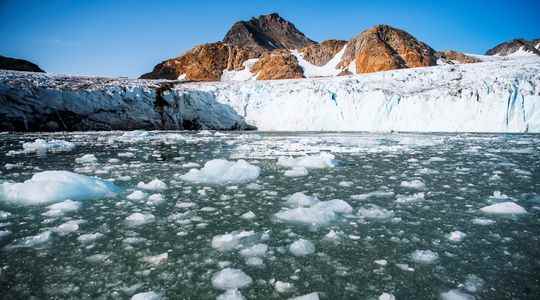In the depths of the icy Arctic sea, viruses exist. They are so far preserved in ice, completely frozen in short. But climate change could change that. Indeed, an English study, published in the biological research journal of the Royal Society of London for the Improvement of Natural Knowledge (the equivalent of the Academy of Sciences in France), suggests that global warming could cause “viral overflow”. Which means that hitherto helpless viruses could come into contact with new hosts in other environments as the ice melts. As a reminder, to replicate and spread, viruses need a host (human, plant, moss), using if necessary a host lacking immunity, as shown by the recent Covid-19 pandemic with the man.
Viruses 300 meters under the ice
Canadian scientists have thus investigated whether climate change could favor such a scenario in the Arctic environment of Lake Hazen. Located in the far north of Canada, it is the largest lake located beyond the Arctic Circle. “Indeed, global warming and rapid environmental transitions can both increase the risk of spillover by varying the overall distribution and dynamics of viruses,” explain the scientists in the introduction. “As the climate changes, the metabolic activity of the Arctic microbiosphere also changes, which in turn affects many ecosystem processes such as the emergence of new pathogens.”
For their research, the scientists took samples from the bed of a river that feeds it when the ice melts during the summer, as well as others from the bottom of the lake. They further state that it required drilling two meters of ice before reaching the bottom of the icy waters of the lake, almost 300 meters away. Using ropes, a snowmobile then hoisted up the sediments, which were subsequently sequenced for their DNA and RNA, the genetic code and the tool for replication of life. “This allowed us to determine which viruses were in a given environment, and which potential hosts were also there”, explained to Agence France Presse Stéphane Aris-Brosou, associate professor in the department of biology of the University. of Ottawa, who supervised the study. The team of researchers then tried to explore how susceptible the viruses were to switching hosts, by looking at the equivalent of their respective family trees.
Arrivals of new guests in perspective
“We tried to measure how similar these (family) trees were,” Audrée Lemieux, from the University of Montreal, first author of the study, told AFP. Similar genealogies suggest the virus evolved with its host, while differences indicate it may have switched hosts. And if he’s done it at least once, he’s likely to do it again. Result: the analyzes showed large differences in the genealogical trees of the viruses and their hosts in the sediments extracted from the bottom of the lake.
The researchers also note that the differences were less pronounced in the bed of the river feeding the lake. “A possible explanation is that as glacial runoff increases, the force of glacier erosion also increases, which transports the contents of the river bed and banks into the lake,” the study says. “This erosion would therefore eliminate topsoil organisms from this environment, and therefore limit the risks of interactions between viruses and hosts, i.e. limit the risk of spillover”.
On the other hand, the acceleration of the melting of the glaciers feeding the lake has also increased the quantity of sediments which are transported there. “This will put hosts and viruses in contact that would not normally have been,” explained Audrée Lemieux. Nevertheless, the authors of the study were careful to specify that they do not foresee a viral overflow or a pandemic. “The probability of dramatic events remains very low”, according to Audrée Lemieux. But according to the researchers, the risk could increase with continued global warming, as new hosts could venture into previously inhospitable regions. The possibility of an overflow is “completely unpredictable, and its consequences too, ranging from mild to a true pandemic”, she added. This is the first time such a study has been conducted in an environment like the Arctic.
